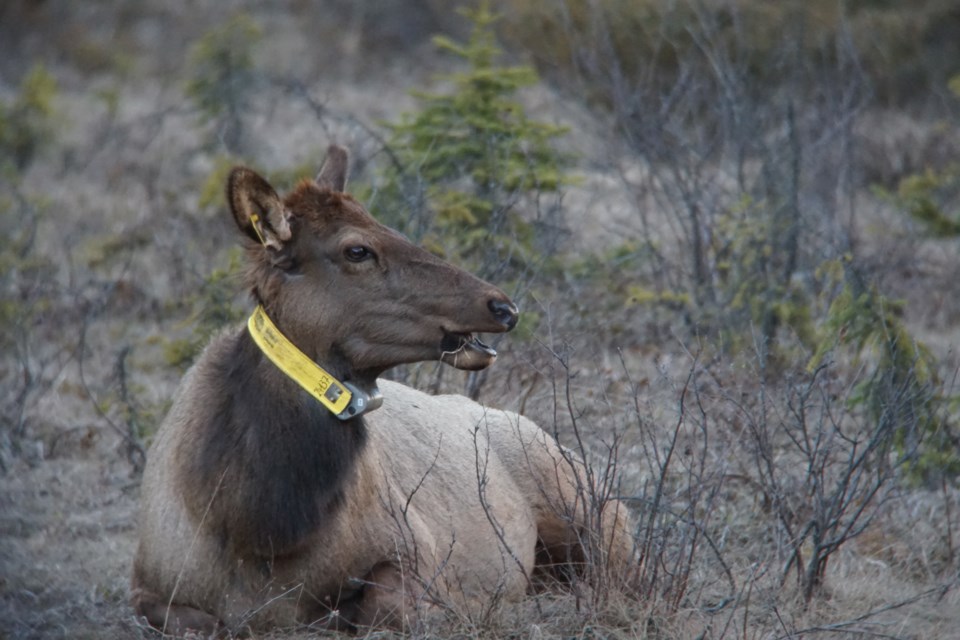YOHO NATIONAL PARK – Why did the elk cross the road? To get to the other side to munch on nutritious shrubs and grasses.
While elk typically avoid crossing busy roads as cars and trucks buzz by, a new study found the Field elk herd in Yoho National Park will take that risk if it means they can get to food in shrubby avalanche paths and grassy meadows located on both sides of the Trans-Canada Highway.
Researchers said they wanted to know where elk graze for food, when they move between foraging patches, and how they make those decisions, as well as learn more about their migration and seasonal ranges.
“The biggest question was definitely about how often they cross the highway and when and where they crossed,” said lead researcher Marie-Pier Poulin from the University of Wyoming’s zoology and physiology department.
“We did find they’re balancing risks and rewards and adjusting when they cross the highway and where they cross the highway if that means that they can go to a foraging patch if there’s a lot of food.”
The study, called Dynamic balancing of risks and rewards in a large herbivore: Further extending predator-prey concepts to road ecology, was published in the Journal of Animal Ecology this summer.
Parks Canada put GPS tracking collars on 14 female elk from the Field herd between October 2019 and November 2020 that recorded each animal’s location every hour, allowing researchers to identify hot spots for crossing the Trans-Canada Highway.
In all, 3,400 elk highway crossings were recorded from the collared elk over the 21 months, averaging about 16 times per month per elk.
“No collared female elk was hit on the road and killed in this time, so I think they make good overall decisions,” said Poulin.
Seth Cherry, one of the study’s authors and a Parks Canada wildlife ecologist with Lake Louise, Yoho and Kootenay, said it was suspected the elk herd headed from Kicking Horse Valley near Field to the Little Yoho Valley area every summer.
“We knew that they moved to higher ground in the summer, but we didn't exactly know where they were going, and we didn't know a lot about their specific habitat use in the winter either around the Field area,” he said.
“Through this study, we were able to learn new information about their seasonal ranges, movement decisions, and highway crossing habits.”
The research showed with long winter and short summers in Yoho, elk spend between nine and 11 months of the year on low-elevation winter range in the valley bottom near Field, which extends about one kilometre on each side of the Trans-Canada Highway.
Elk arrive near the road at the end of fall migration in September and depart for spring migration in about June, which coincides with the snow melting and vegetation green-up at higher elevations.
“Their migration route’s quite short, but does involve going across that highway,” said Cherry.
This means the study’s findings have implications for future twinning of the remaining 40-km two-lane stretch of undivided highway in Yoho National Park between Sherbrooke Creek and western boundary.
The preliminary design and environmental assessment for the section, known as phase IVB, was wrapped up in 2021. It has been given the go-ahead to proceed when federal funding becomes available.
When elk are present in their valley-bottom winter range near Field, traffic on the highway averages 206 vehicles per hour, up to a high of 1,650 vehicles per hour and is the highest during the afternoon and in early fall.
The study found elk generally avoided crossing the highway when traffic volumes were high, but did take greater risks to get to food on the other side, particularly in spring when perhaps the female elk have greater nutritional needs coming out of a food-scarce winter.
Poulin said changes in the road configuration, potential changes in traffic volumes, and changes in available habitat during and after the highway expansion could affect the ability of elk to navigate the risk.
But she said the research will help with wildlife mitigation measures on the highway in the narrow Kicking Horse Valley, such as crossing structures and fences.
“It allowed us to quantify if the road is twinned and becomes wider, then how much food would be lost on each side of the road,” she said.
In order to survive, animals must identify and mitigate exposure to risk, including when predators are around.
Cherry said elk will take risks if there are predators around if they’re nutritionally stressed after a hard winter, or great energy requirements before and during spring calving.
“The fact that they’re able to balance those risks and rewards is pretty neat,” he said.




